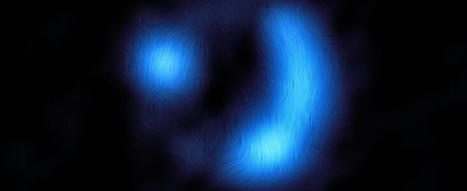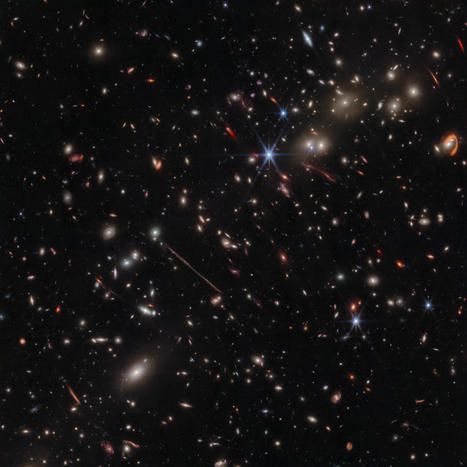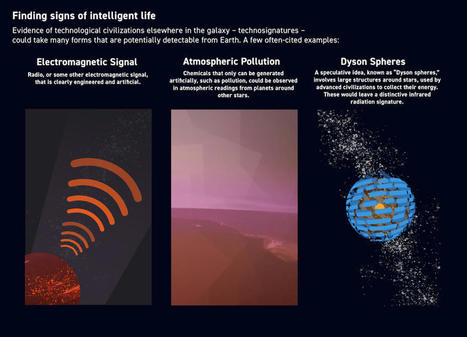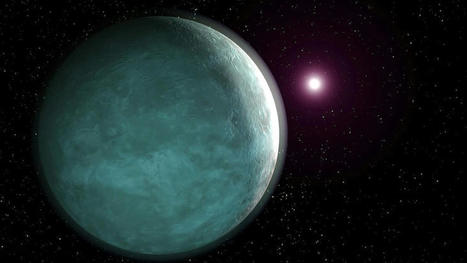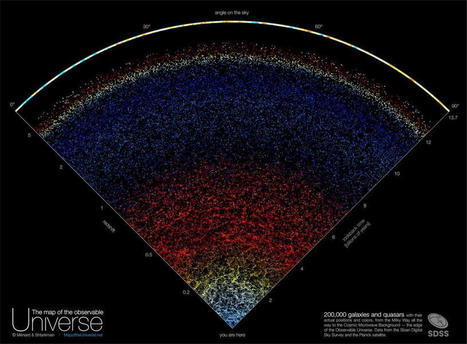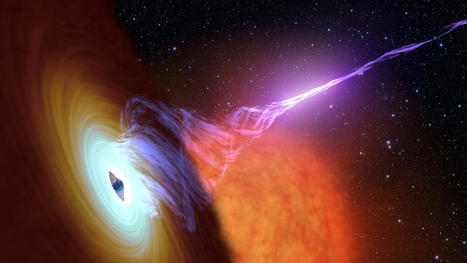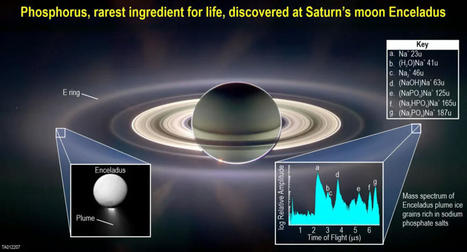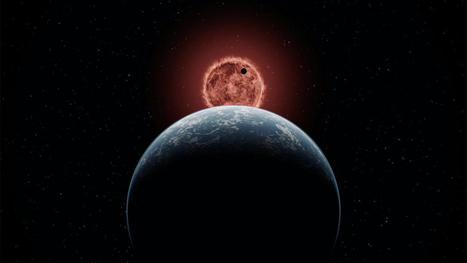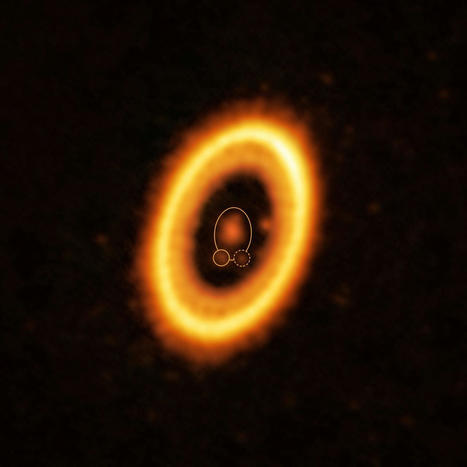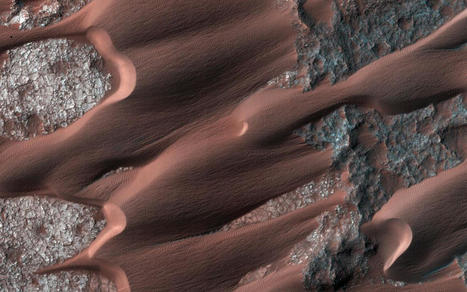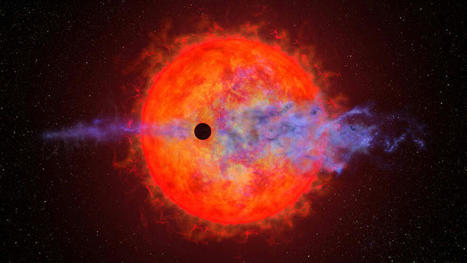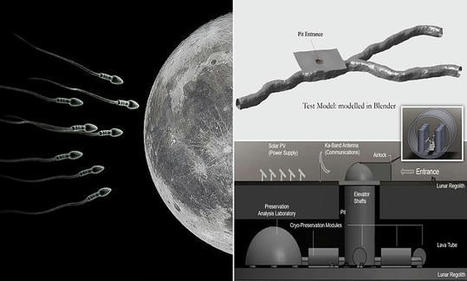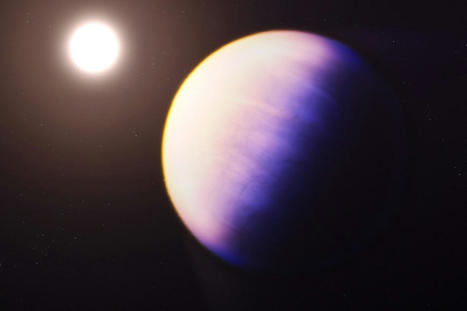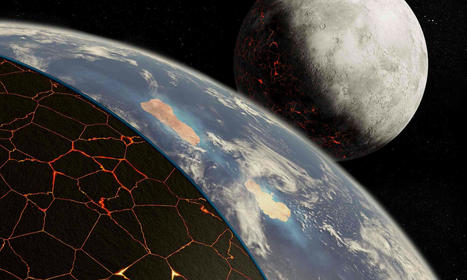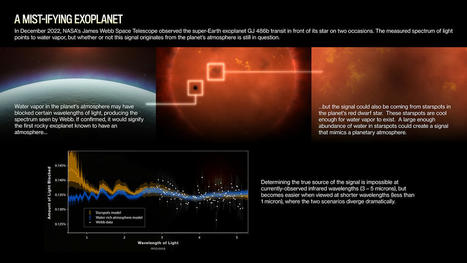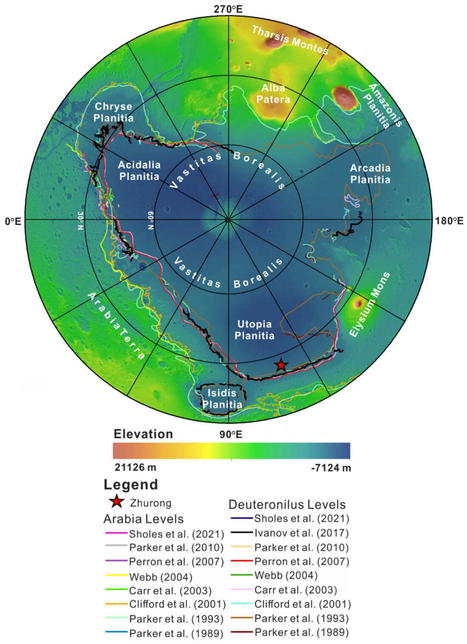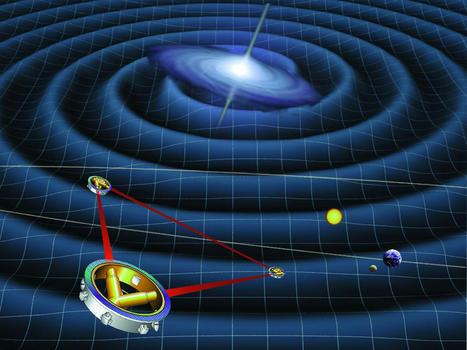 Your new post is loading...
Astronomers expect to see some repeating radio signals in space, but they usually blink on and off much more quickly. In 2022, astronomers made an intriguing discovery: a radio signal in space that switched on and off every 18 minutes. Astronomers expect to see some repeating radio signals in space, but they usually blink on and off much more quickly. The most common repeating signals come from pulsars, rotating neutron stars that emit energetic beams like lighthouses, causing them to blink on and off as they rotate towards and away from the Earth. Pulsars slow down as they get older, and their pulses become fainter, until eventually they stop producing radio waves altogether. Our unusually slow pulsar could best be explained as a magnetar—a pulsar with exceedingly complex and powerful magnetic fields that could generate radio waves for several months before stopping. Unfortunately, we detected the source using data gathered in 2018. By the time we analyzed the data and discovered what we thought might be a magnetar it was 2020, and it was no longer producing radio waves. Without additional data, we were unable to test our magnetar theory. Our Universe is vast, and so far every new phenomenon we’ve discovered has not been unique. We knew that if we looked again, with well-designed observations, we had a good chance of finding another long-period radio source. So, we used the Murchison Widefield Array radio telescope in Western Australia to scan our Milky Way galaxy every three nights for several months. We didn’t need to wait long. Almost as soon as we started looking, we found a new source, in a different part of the sky, this time repeating every 22 minutes. At last, the moment we had been waiting for. We used every telescope we could find, across radio, X-ray, and optical light, making as many observations as possible, assuming it would not be active for long. The pulses lasted five minutes each, with gaps of 17 minutes between. Our object looked a lot like a pulsar, but spinning 1,000 times slower.
Using the Atacama Large Millimeter/submillimeter Array (ALMA), astronomers have detected the magnetic field of a galaxy so far away that its light has taken more than 11 billion years to reach us: we see it as it was when the Universe was just 2.5 billion years old. The result provides astronomers with vital clues about how the magnetic fields of galaxies like our own Milky Way came to be. Lots of astronomical bodies in the Universe have magnetic fields, whether it be planets, stars or galaxies. “Many people might not be aware that our entire galaxy and other galaxies are laced with magnetic fields, spanning tens of thousands of light-years,” says James Geach, a professor of astrophysics at the University of Hertfordshire, UK, and lead author of the study published today in Nature. “We actually know very little about how these fields form, despite their being quite fundamental to how galaxies evolve,” adds Enrique Lopez Rodriguez, a researcher at Stanford University, USA, who also participated in the study. It is not clear how early in the lifetime of the Universe, and how quickly, magnetic fields in galaxies form because so far astronomers have only mapped magnetic fields in galaxies close to us. Now, using ALMA, in which the European Southern Observatory (ESO) is a partner, Geach and his team have discovered a fully formed magnetic field in a distant galaxy, similar in structure to what is observed in nearby galaxies. The field is about 1000 times weaker than the Earth’s magnetic field, but extends over more than 16 000 light-years. “This discovery gives us new clues as to how galactic-scale magnetic fields are formed,” explains Geach. Observing a fully developed magnetic field this early in the history of the Universe indicates that magnetic fields spanning entire galaxies can form rapidly while young galaxies are still growing.
Despite being larger than the original Starlink satellites, the new "Mini" version is fainter, meeting astronomers' recommendations. SpaceX launched their first batch of second-generation Starlink satellites on February 27th. These spacecraft are called “Mini,” but they are only small in comparison to the full-size satellites that will come later. The 116 square meters of surface area make them more than four times the size of the first-generation spacecraft. The Minis’ large dimensions were an immediate concern for professional and amateur astronomers alike because area usually translates to brightness. However, SpaceX changed their physical design and concept of operations (conops) in order to mitigate their brightness. The company developed a highly reflective dielectric mirror film and a low-reflectivity black paint, which are applied to several parts of the spacecraft body. The mirror-like surface reflects sunlight into space instead of scattering it toward observers on the ground. In addition, the solar panels can be oriented so that observers do not see their sunlit sides. The brightness mitigation plan sounded promising but measurements were needed to determine its effectiveness. So, a group of satellite observers began recording magnitudes. Scott Harrington recorded the first data point visually on March 14th. He has since obtained 125 additional magnitudes from his dark-sky location in Arkansas. Meanwhile, Andreas Hornig developed software to process video observations. He derived 108 magnitude measurements recorded from Macedonia on the night of April 12th alone. In all, we have acquired 506 brightness measurements for our study. SpaceX launched three additional batches of 21 or more Mini satellites in April, May, and June. These spacecraft ascend from low, orbit-insertion heights toward their eventual altitude at 560-km (350 mi). Until May, we were observing Mini satellites at all heights without knowing whether they were operating for brightness mitigation. Then Richard Cole in the UK noticed that some spacecraft had leveled off at 480 km. He reasoned that these satellites might already be in mitigation mode and suggested that we prioritize them. We found that the Minis at that height were several magnitudes fainter than those at other altitudes. SpaceX sent us a message on May 16th confirming that Richard was correct. Now that we could distinguish between mitigated and unmitigated spacecraft, we began to characterize the brightness of each group, prioritizing measurements for those satellites that were already operational. Observed brightness indicates how severely satellites impact celestial observations. The average magnitude for mitigated Mini spacecraft in our database is 7.1, just below the limit set by astronomers’ recommended guidelines. So, most of them are invisible to the unaided eye and do not interfere greatly with research.
A new image of the galaxy cluster known as "El Gordo" is revealing distant and dusty objects never seen before, and providing a bounty of fresh science. The infrared image, taken by NASA's James Webb Space Telescope, displays a variety of unusual, distorted background galaxies that were only hinted at in previous Hubble Space Telescope images. El Gordo is a cluster of hundreds of galaxies that existed when the universe was 6.2 billion years old, making it a "cosmic teenager." It's the most massive cluster known to exist at that time. ("El Gordo" is Spanish for the "Fat One.") The team targeted El Gordo because it acts as a natural, cosmic magnifying glass through a phenomenon known as gravitational lensing. Its powerful gravity bends and distorts the light of objects lying behind it, much like an eyeglass lens. "Lensing by El Gordo boosts the brightness and magnifies the sizes of distant galaxies. This lensing effect provides a unique window into the distant universe," said Brenda Frye of the University of Arizona. Frye is co-lead of the PEARLS-Clusters branch of the Prime Extragalactic Areas for Reionization and Lensing Science (PEARLS) team and lead author of one of four papers analyzing the El Gordo observations. The Fishhook Within the image of El Gordo, one of the most striking features is a bright arc represented in red at upper right. Nicknamed "El Anzuelo" (The Fishhook) by one of Frye's students, the light from this galaxy took 10.6 billion years to reach Earth. Its distinctive red color is due to a combination of reddening from dust within the galaxy itself and cosmological redshift due to its extreme distance. By correcting for the distortions created by lensing, the team was able to determine that the background galaxy is disk-shaped but only 26,000 light-years in diameter -- about one-fourth the size of the Milky Way. They also were able to study the galaxy's star formation history, finding that star formation was already rapidly declining in the galaxy's center, a process known as quenching. "We were able to carefully dissect the shroud of dust that envelops the galaxy center where stars are actively forming," said Patrick Kamieneski of Arizona State University, lead author on a second paper. "Now, with Webb, we can peer through this thick curtain of dust with ease, allowing us to see firsthand the assembly of galaxies from the inside out."
Signs of life beyond Earth could take forms that are clearly artificial – radio or light signals, or even evidence of large-scale engineering. Our first confirmed proof of life beyond Earth might not involve biology at all. It’s possible that we might intercept communication through electromagnetic waves, like radio, or find telescopic evidence of epic engineering. While the search remains largely focused on non-technological life, NASA scientists also have begun to consider what technological traces of intelligent life – “technosignatures” – might look like. They wouldn’t come from planets in our solar system, but rather far-flung exoplanets that we cannot see up close. Among the possibilities are laser or radio pulses, signs of artificial chemicals in the atmospheres of distant planets, or “Dyson spheres” – massive structures built around stars to collect their energy. And as acceptance in the scientific community slowly grows, a field once derided as a search for “little green men” is showing early signs of blossoming into a mature, serious investigation. “That’s something we’ve worked very hard on: to establish our legitimacy, and distance ourselves from pseudo-science,” said Jill Tarter, an astronomer known for decades as a leader in the search for intelligent life beyond Earth. “If anything, my conviction that this is an important and reasonable thing to do has increased.” Jill Tarter is the co-founder and former director of the Center for SETI (Search for Extraterrestrial Intelligence) Research at the SETI Institute, as well as the inspiration for the main character in Carl Sagan’s 1985 novel “Contact.” She says one of the biggest challenges today is moving the search for signs of technology beyond just radio signals. “We still want to look at all the sky all the time, at all wavelengths,” Tarter said, including pulses of laser light that might be used for communication. Another challenge is short-lived “transient” signals, one-time events that can be bright and energetic. Mixed among the many natural sources for such signals, like gamma-ray bursts or supernovae, might be artificial transients from distant civilizations – an engineered signal lasting less than a few minutes. But teasing them apart likely would require enormous amounts of computer time. "We’re trying to figure out how to do that,” Tarter said. “That is our focus now.” This is the fifth in a series of articles on how NASA is searching for life in the cosmos. Read Part 1 | Part 2 | Part 3 | Part 4
In total 12 people have walked on the moon. Neil Armstrong made history by becoming the first person to set foot on the moon. 1 + 2. Apollo 11 - July 21, 1969 Neil Armstrong made history by becoming the first person to set foot on the lunar surface, before he he was followed by crewmate Edwin 'Buzz' Aldrin. 3 + 4. Apollo 12 - November 19 and 20, 1969 Pete Conrad and Alan Bean were the moon walkers on the Apollo 12 mission. The Apollo 12 crew experienced two lightning strikes just after their Saturn V rocket launched. 5 + 6. Apollo 14 - February 5, 1971 Alan Shepard and Edgar Mitchell were part of the Apollo 14 mission. They launched on January 31, 1971, and landed in the Fra Mauro region of the moon, the original destination for Apollo 13. 7 + 8. Apollo 15 - July 31, 1971 Dave Scott and James Irwin landed on the moon and stayed for three days, until August 2. 9 + 10. Apollo 16 - April 21, 1972 John Young and Charlie Duke were the next men to walk on the moon. When the crew reached lunar orbit, the mission almost had to be aborted because of a problem with the command and service module's main engine. 11 + 12. Apollo 17 - December 11, 1972 The final people to walk on the moon were Eugene (Gene) Cernan and Harrison (Jack) Schmitt. Before he left the moon, Cernan scratched the initials of his daughter Tracy into the lunar regolith. Since the moon does not experience weather conditions like wind or rain to erode anything away, her initials should stay there for a very long time.
A scorching hot world where metal clouds rain drops of titanium and other metals has been designated as the most reflective planet ever observed outside of our Solar System by astronomers. Key points: - The side of exoplanet LTT9779b facing its star reaches 2,000 degrees Celsius
- This helps it form metallic clouds that act like a shield and reflects 80 per cent of light
- Scientists say this also prevents its atmosphere from being blown away, defying the odds
This strange world, which is more than 260 light years from Earth, reflects 80 per cent of the light from its host star, according to new observations from Europe's exoplanet-probing Cheops space telescope. That makes it the first exoplanet comparably as shiny as Venus, which is the brightest object in our night sky other than the Moon. First discovered in 2020, the Neptune-sized planet called LTT9779b orbits its host star in just 19 hours. Because it is so close, the side of the planet facing its star is a sizzling 2,000˚C, which is considered far too hot for clouds to form. Yet LTT9779b seems to have plenty of them. "It was really a puzzle," said Vivien Parmentier, a researcher at France's Cote d'Azur Observatory and co-author of a new study in the journal Astronomy and Astrophysics. The researchers then "realized we should think about this cloud formation in the same way as condensation forming in a bathroom after a hot shower," he said in a statement. Like running hot water steams up a bathroom, a scorching stream of metal and silicate — the mineral of which glass is made — oversaturated LTT9779b's atmosphere until metallic clouds formed, he said. These clouds "act like a mirror," reflecting away light, according to the European Space Agency's Cheops project scientist Maximilian Guenther.
What if you could see out to the edge of the observable universe? You would see galaxies, galaxies, galaxies, and then, well, quasars, which are the bright centers of distant galaxies. To expand understanding of the very largest scales that humanity can see, a map of the galaxies and quasars found by the Sloan Digital Sky Survey from 2000 to 2020 -- out to near the edge of the observable universe -- has been composed. Featured: One wedge from this survey encompasses about 200,000 galaxies and quasars out beyond a look-back time of 12 billion years and cosmological redshift 5. Almost every dot in the nearby lower part of the illustration represents a galaxy, with redness indicating increasing redshift and distance. Similarly, almost every dot on the upper part represents a distant quasar, with blue-shaded dots being closer than red. Clearly shown among many discoveries, gravity between galaxies has caused the nearby universe to condense and become increasingly more filamentary than the distant universe.
The black hole, located about 656 million light-years away from Earth, has a powerful jet streaming from its core. This jet, which is blasted out at light-like speeds, has “drastically” changed directions. The black hole just changed its direction in a way that is perpendicular to our line of sight, and it now faces Earth. This is a very exceptional case of jet reorientation and has led to the redefinition of the galaxy that houses this black hole. The Peculiar Properties of PBC J2333.9-2343 PBC J2333.9-2343 is a distant galaxy that spans four million light-years. It shines strongly in radio wavelengths, making it a radio galaxy. The core of this galaxy had blasted jets in the past but had long gone quiet. In the latest research, astronomers found that the core had once again stirred the jets back to life, and one of them had changed its direction. Given the sharp change in the jet’s orientation, astronomers have redefined the giant radio galaxy into one with a blazar at its center. Blazars are galaxies whose cores have jets aimed directly at Earth. This is the first time astronomers have observed a galaxy transform from one group to another, marking a significant milestone in our understanding of these celestial objects. The Mystery of Jet Reorientation While the black hole just changed its direction, the reasons behind such changes are not very well understood. Some astronomers speculate that mergers of galaxies or black holes contribute to the intermittent bursts of jet activity, and that the directions of the jets change between bursts. This erratic behavior of jets is also observed in bright but rare X-shaped galaxies. Conclusion: A Cosmic First and Its Implications The black hole just changed its direction, marking a cosmic first that is reshaping our understanding of black holes and their behavior. As scientists continue to study PBC J2333.9-2343 and other celestial objects, we can expect to gain more insights into the nature of black holes and their jets. These insights will not only help us understand these celestial objects better but also shed light on the mysteries of the cosmos.
Astronomers have detected, a critical life component, phosphate on Saturn's moon Enceladus, marking a significant step forward in the search for extraterrestrial life. Phosphate is vital for all life on Earth. It forms the backbone of DNA and RNA, the genetic material that carries the instructions for life. It is also a key component of ATP (adenosine triphosphate), the molecule that provides energy for cellular processes, and phospholipids, which form the membranes of cells. The discovery of phosphates on Saturn’s moon Enceladus is the first to report direct evidence of phosphorus on an extraterrestrial ocean world, making it a significant milestone in astrobiology. The detection of phosphates on Saturn’s moon Enceladus was made possible by data from NASA’s Cassini mission. Launched in 1997, Cassini spent 13 years exploring Saturn, its rings, and its moons. One of its most significant discoveries was the detection of a subsurface ocean on Enceladus, which was confirmed by the spacecraft’s observations of geysers erupting from the moon’s south pole. These geysers spew water ice particles into space, some of which supply Saturn’s E ring. The Cassini spacecraft was equipped with the Cosmic Dust Analyzer, which analyzed individual ice grains emitted from Enceladus and sent those measurements back to Earth. In the new study, researchers used data collected from Cassini’s Cosmic Dust Analyzer. They found sodium phosphate molecules in 9 of 345 ice grains Cassini analyzed as it passed through Saturn’s outer E ring. The detection of phosphates on Saturn’s moon Enceladus is a stunning result for astrobiology and a major step forward in the search for life beyond Earth. The high concentration of phosphates in Enceladus’ ocean satisfies one of the strictest requirements in establishing whether celestial bodies are habitable. The discovery of phosphate on Saturn’s moon Enceladus reinforces the idea of the potential habitability of ice-covered ocean worlds across the solar system, beyond surface ocean worlds like Earth. Worlds with an interior ocean like Enceladus can occur over a much wider range of distances, greatly expanding the number of habitable worlds likely to exist across the galaxy. This discovery has profound implications for our understanding of where life might exist beyond Earth. It suggests that the conditions necessary for life as we know it could exist on moons and planets far from the warmth of their parent star, in the cold depths of subsurface oceans. With the discovery of phosphates on Saturn’s moon Enceladus, the next step is clear – we need to go back to Enceladus to see if the habitable ocean is actually inhabited. This finding has made the search for extraterrestrial life in our solar system more exciting and promising. Future missions to Enceladus could involve landers or even submarines designed to probe its subsurface ocean. Such missions could collect and analyze samples directly from the ocean, potentially detecting signs of life such as microorganisms or organic molecules.
The system, named TOI-2096, consists of two planets orbiting a cool star in a synchronized dance at approximately 150 light-years from Earth. A study led by researchers of the University of Liège and the CSIC -- using observations from NASA's TESS telescope -- presents the detection of a system of two planets slightly larger than Earth orbiting a cold star in a synchronized dance. Named TOI-2096, the system is located 150 light-years from Earth. The discovery is the result of a close collaboration between European and American universities and was made possible by the US space mission TESS (Transiting Exoplanet Survey Satellite), which aims to find planets orbiting nearby bright stars. "TESS is conducting an all-sky survey using the transit method, that is, monitoring the stellar brightness of thousands of stars in the search for a slight dimming, which could be caused by a planet passing between the star and the observer. However, despite its power to detect new worlds, the TESS mission needs support from ground-based telescopes to confirm the planetary nature of the detected signals," explains Francisco J. Pozuelos, astrophysicist, first author of the paper, former member of the ExoTIC laboratory at the Univeristy of Liège, and who has now joined the Spanish National Research Council (IAA-CSIC). The planets TOI-2096 b and TOI-2096 c were observed with an international network of ground-based telescopes, allowing their confirmation and characterization. The majority of the transits were obtained with telescopes of the TRAPPIST and SPECULOOS projects led by the University of Liège. "Making an exhaustive analysis of the data, we found that the two planets were in resonant orbits: for each orbit of the outer planet, the inner planet orbits the star twice," says Mathilde Timmermans, a doctoral student and second author of the scientific paper. Their periods are therefore very close to being a multiple of each other with about 3.12 days for planet b and about 6.38 days for planet c. This is a very particular configuration, and it causes a strong gravitational interaction between the planets. This interaction delays or accelerates the passage of the planets in front of their star and could lead to the measurement of the planetary masses using larger telescopes in the near future." The researchers behind the discovery estimate that the radius of planet b -- the closest to its star -- is 1.2 times that of Earth, hence the name 'super-Earth'. Its properties could be similar to Earth's: a planet with a mostly rocky composition, possibly surrounded by a thin atmosphere. Similarly, the radius of planet c is 1.9 times the radius of the Earth and 55% that of Neptune, which could place the planet in the category of 'mini-Neptunes', planets composed of a rocky and icy core surrounded by extended hydrogen- or water-rich atmospheres, such as Uranus and Neptune in our Solar System. These sizes are very interesting because the number of planets with a radius between 1.5 and 2.5 Earth radii is smaller than what theoretical models predict, making these planets a rarity. These planets are of crucial importance given their sizes," notes Mathilde Timmermans, "the formation of super-Earths and mini-Neptunes remains a mystery today. There are several formation models trying to explain it, but none fits the observations perfectly. TOI-2096 is the only system found to date that has a super-Earth and a mini-Neptune precisely at the sizes where the models contradict each other. In other words, TOI-2096 may be the system we've been looking for to understand how these planetary systems have formed." "Furthermore, these planets are among the best in their category to study their possible atmospheres," explains Francisco J. Pozuelos. Thanks to the relative sizes of the planets with respect to the host star, as well as the brightness of the star, we find that this system is one of the best candidates for a detailed study of their atmosphere with the JWST space telescope. We hope to be able to do this quickly by coordinating with other universities and research centers. These studies will help confirm the presence of an atmosphere, extensive or not, around planets b and c and thus give us clues as to their formation mechanism."
It appears that AI has found potential alien "technosignatures" hidden in radio signals from space that could point to alien technology. The goal of the search for extraterrestrial intelligence (SETI) is to quantify the prevalence of technological life beyond Earth via their ‘technosignatures’. One theorized technosignature is narrowband Doppler drifting radio signals. The principal challenge in conducting SETI in the radio domain is developing a generalized technique to reject human radiofrequency interference. Now, astronomers presented a comprehensive deep-learning-based technosignature search on 820 stellar targets from the Hipparcos catalogue, totaling over 480 h of on-sky data taken with the Robert C. Byrd Green Bank Telescope as part of the Breakthrough Listen initiative. They implement a novel β-convolutional variational autoencoder to identify technosignature candidates in a semi-unsupervised manner while keeping the false-positive rate manageably low, reducing the number of candidate signals by approximately two orders of magnitude compared with previous analyses on the same dataset. This work returned eight promising extraterrestrial intelligence signals of interest not previously identified. Re-observations on these targets have so far not resulted in re-detections of signals with similar morphology. This machine-learning approach presents itself as a leading solution in accelerating SETI and other transient research into the age of data-driven astronomy.
Alpha Centauri is our closest stellar neighbor, a binary star system located just 4.376 light-years away. Despite its proximity, repeated astronomical surveys have failed to find hard evidence of extrasolar planets in this system. Part of the problem is that the system consists of two stars orbiting each other, which makes detecting exoplanets through the two most popular methods very challenging. In 2019, Breakthrough Initiatives announced they were backing a new project to find exoplanets next door – the Telescope for Orbit Locus Interferometric Monitoring of our Astronomical Neighbourhood (TOLIMAN, after the star’s ancient name in Arabic). This low-cost mission concept was designed by a team from the University of Sydney, Australia, and aims to look for potentially-habitable exoplanets in the Alpha Centauri system using the Astrometry Method. This consists of monitoring a star’s apparent position in the sky for signs of wobble, indicating that gravitational forces (like planets) are acting on it. Recently, the University of Sydney signed a contract with EnduroSat, a leading microsatellites and space services provider, to provide the delivery system and custom-built minisatellite that will support the mission when it launches. Alpha Centauri consists of a G-type primary star (similar to our Sun) and a K-type (orange dwarf) secondary. Because of its binary nature, it has been very difficult to discern possible signals from this system that could be the result of exoplanets. This includes the Transit Method, where astronomers monitor stars for periodic dips in luminosity that may indicate planets passing in front of the star (transiting) relative to the observer. But since the stars also make transits, dips in luminosity are very common. TOLIMAN will search for planets in the habitable or “Goldilocks” zone around two Sun-like stars in the system, Alpha Centauri A and B, which are just four light years from Earth. Mission leader Professor Peter Tuthill from the University of Sydney said: “That’s tantalizingly close to home. Astronomers have discovered thousands of exoplanets outside our own solar system but most are thousands of light years away and beyond our reach. Modern satellite technology will allow us to explore our celestial backyard and perhaps lay the groundwork for visionary future missions spanning the interstellar voids to the Centauri system.”
Discovering exoplanets is a major technological challenge, even for large space telescopes. For a mini satellite, the task is daunting. To achieve this, the team is developing a small custom-designed space telescope capable of extremely fine measurements. The satellite needs to fit the telescope within a limited volume – just 12 litres – and maintain its thermal and mechanical stability with exquisite precision using active systems. EnduroSat will provide the delivery system for the custom-built mini satellite that supports the mission.
“Any exoplanets we find that close to Earth can be followed up with other instruments, giving excellent prospects for discovering and analysing atmospheres, surface chemistry or even fingerprints of a biosphere – the tentative signs of life,” said Professor Tuthill from the Sydney Institute for Astronomy and School of Physics.
EnduroSat’s flight-proven MicroSat technology can downlink payload data at a speed of 125+ Mbps, which will be critical for downloading all data from prolonged observation sessions.
|
Using the Atacama Large Millimeter/submillimeter Array (ALMA), astronomers have found the possible "sibling" of a planet orbiting a distant star. The team has detected a cloud of debris that might be sharing this planet's orbit, which they believe could be the building blocks of a new planet or the remnants of one already formed. If confirmed, this discovery would be the strongest evidence yet that two exoplanets can share one orbit. "Two decades ago it was predicted in theory that pairs of planets of similar mass may share the same orbit around their star, the so-called Trojan or co-orbital planets. For the first time, we have found evidence in favor of that idea," says Olga Balsalobre-Ruza, a student at the Centre for Astrobiology in Madrid, Spain who led the paper published today in Astronomy & Astrophysics. Trojans, rocky bodies in the same orbit as a planet, are common in our own solar system, the most famous example being the Trojan asteroids of Jupiter—more than 12,000 rocky bodies that are in the same orbit around the sun as the gas giant. Astronomers have predicted that Trojans, in particular Trojan planets, could also exist around a star other than our sun, but evidence for them is scant. "Exotrojans [Trojan planets outside the solar system] have so far been like unicorns: They are allowed to exist by theory but no one has ever detected them," says co-author Jorge Lillo-Box, a senior researcher at the Centre for Astrobiology. Now, an international team of scientists have used ALMA, in which ESO is a partner, to find the strongest observational evidence yet that Trojan planets could exist—in the PDS 70 system. This young star is known to host two giant Jupiter-like planets, PDS 70b and PDS 70c. By analyzing archival ALMA observations of this system, the team spotted a cloud of debris at the location in PDS 70b's orbit where Trojans are expected to exist.
As the hunt for exoplanets continues, astronomers want to find technosignatures of advanced civilizations on them. Two recent reports outline how: In an age of ever-growing numbers of exoplanets circling other stars, it’s natural that astronomers search for signatures of advanced civilizations. Such signatures may have biological or technological origins. What if, instead of looking for radio signals (as SETI and others have done), we look for something a little different? How about evidence of atmospheric pollution produced by technological societies? After all, we’re familiar with it here on Earth. That’s the thrust of a paper in Scientific Reports by MIT’s Sara Seager and an international team of scientists. They suggest that technological civilizations might be uncovered via a hunt for chemicals not created by life. Specifically, the team proposes nitrogen trifluoride (NF3) and sulfur hexafluoride (SF6). They are ideal technosignature gases to find because, as they state in the paper, “Life on Earth is not known to produce any molecules with N–F or S–F bonds, and this includes fully fluorinated N and S compounds.” In fact, the paper states that fluorine is nearly excluded from the chemistry of life on Earth. Other natural processes don’t create it in huge amounts, either. That leaves only artificial (read: industrial) pollution. In other words, those gases would be the atmospheric by-products of industrial activity. Here on Earth, their abundance increased rapidly (from nearly non-existent) since the Industrial Revolution began.
A recent study published in the journal Geology attempts to interpret the patterns of sand dunes, which are mounds frequently formed by aeolian (wind) processes and range in size from small ripples observed on beaches to massive structures observed in the desert. Specifically, the researchers focused on patterns of dune crestlines. Different dune crestline patterns might appear as mundane features, but their formations are often the result of a myriad of influences, including climate change, surface processes, and atmospheric phenomena. However, questions pertaining to the processes responsible for the different crestline patterns have baffled scientists. But the findings from this recent study could provide researchers insights into environmental variances not only on Earth, but other dune-harboring planetary worlds in our own solar system. These currently include three of the four terrestrial planets, Venus, Earth, and Mars; smaller bodies such as Jupiter’s volcanic moon, Io; Saturn’s largest moon, Titan; and even dwarf planet Pluto. “When you look at other planets, all you have is pictures taken from hundreds to thousands of kilometers away from the surface,” said Dr. Mathieu Lapôtre, who is an assistant professor of Earth and planetary sciences in the Stanford Doerr School of Sustainability, and a co-author on the study. “You can see dunes – but that’s it. You don’t have access to the surface. These findings offer a really exciting new tool to decipher the environmental history of these other planets where we have no data.” Dune interactions are defined as when their crestlines are near one another, and it’s these interactions result in the dunes establishing a balance, or equilibrium, with their surrounding environment. Therefore, the researchers hypothesized that a large amount of dune interactions could be interpreted as recent or nearby changes regarding those confined conditions. For this study, the researchers analyzed changes in specific known environmental conditions, including sand quantity and wind direction, using orbital images of dune field sites numbering 30 and 16 on Earth and Mars, respectively. Examples of Earth dune field sites included Rice Valley, White Sands, the Namib Desert, and the Tengger Desert. Examples of Martian dune field sites included Nili Patera, Kaiser Crater, Rabe Crater, and Hargraves Crater.
A young planet whirling around a petulant red dwarf star is changing in unpredictable ways orbit-by-orbit. It is so close to its parent star that it experiences a consistent, torrential blast of energy, which evaporates its hydrogen atmosphere -- causing it to puff off the planet. But during one orbit observed with NASA's Hubble Space Telescope, the planet looked like it wasn't losing any material at all, while an orbit observed with Hubble a year and a half later showed clear signs of atmospheric loss. This extreme variability between orbits shocked astronomers. "We've never seen atmospheric escape go from completely not detectable to very detectable over such a short period when a planet passes in front of its star," said Keighley Rockcliffe of Dartmouth College in Hanover, New Hampshire. "We were really expecting something very predictable, repeatable. But it turned out to be weird. When I first saw this, I thought 'That can't be right.'" Rockcliffe was equally puzzled to see, when it was detectable, the planet's atmosphere puffing out in front of the planet, like a headlight on a fast-bound train. "This frankly strange observation is kind of a stress-test case for the modeling and the physics about planetary evolution. This observation is so cool because we're getting to probe this interplay between the star and the planet that is really at the most extreme," she said. Located 32 light-years from Earth, the parent star AU Microscopii (AU Mic) hosts one of the youngest planetary systems ever observed. The star is less than 100 million years old (a tiny fraction of the age of our Sun, which is 4.6 billion years old). The innermost planet, AU Mic b, has an orbital period of 8.46 days and is just 6 million miles from the star (about 1/10th the planet Mercury's distance from our Sun). The bloated, gaseous world is about four times Earth's diameter. AU Mic b was discovered by NASA's Spitzer and TESS (Transiting Exoplanet Survey Satellite) space telescopes in 2020. It was spotted with the transit method, meaning telescopes can observe a slight dip in the star's brightness when the planet crosses in front of it. Red dwarfs like AU Microscopii are the most abundant stars in our Milky Way galaxy. They therefore should host the majority of planets in our galaxy. But can planets orbiting red dwarf stars like AU Mic b be hospitable to life? A key challenge is that young red dwarfs have ferocious stellar flares blasting out withering radiation. This period of high activity lasts a lot longer than that of stars like our Sun. The flares are powered by intense magnetic fields that get tangled by the roiling motions of the stellar atmosphere. When the tangling gets too intense, the fields break and reconnect, unleashing tremendous amounts of energy that are 100 to 1,000 times more energetic than our Sun unleashes in its outbursts. It's a blistering fireworks show of torrential winds, flares, and X-rays blasting any planets orbiting close to the star. "This creates a really unconstrained and frankly, scary, stellar wind environment that's impacting the planet's atmosphere," said Rockcliffe. Under these torrid conditions, planets forming within the first 100 million years of the star's birth should experience the most amount of atmospheric escape. This might end up completely stripping a planet of its atmosphere. "We want to find out what kinds of planets can survive these environments. What will they finally look like when the star settles down? And would there be any chance of habitability eventually, or will they wind up just being scorched planets?" said Rockcliffe. "Do they eventually lose most of their atmospheres and their surviving cores become super-Earths? We don't really know what those final compositions look like because we don't have anything like that in our solar system." While the star's glare prevents Hubble from directly seeing the planet, the telescope can measure changes in the star's apparent brightness caused by hydrogen bleeding off the planet and dimming the starlight when the planet transits the star. That atmospheric hydrogen has been heated to the point where it escapes the planet's gravity. The never-before-seen changes in atmospheric outflow from AU Mic b may indicate swift and extreme variability in the host red dwarf's outbursts. There is so much variability because the star has a lot of roiling magnetic field lines. One possible explanation for the missing hydrogen during one of the planet's transits is that a powerful stellar flare, seen seven hours prior, may have photoionized the escaping hydrogen to the point where it became transparent to light, and so was not detectable. Another explanation is that the stellar wind itself is shaping the planetary outflow, making it observable at some times and not observable at other times, even causing some of the outflow to "hiccup" ahead of the planet itself. This is predicted in some models, like those of John McCann and Ruth Murray-Clay from the University of California at Santa Cruz, but this is the first kind of observational evidence of it happening and to such an extreme degree, say researchers.
The lunar gene bank - which could also house seed and spore samples - is envisaged as being built under the lunar surface, in a hollow, cooled lava tube. Extinction insurance for planet earth is envisioned by sending sperm and egg samples from 6.7 million species to the moon for safekeeping. How could earth species be destroyed to require a “backup”? - To protect Earth’s species diversity, we presently store genetic material in vaults
- Material including seeds and spores could be used to recover lost species
- But gene banks on Earth are vulnerable to the catastrophes they insure against
- US experts propose to more safely store specimens in lava tubes on the moon
- The deposits would be cryogenically frozen and tended by levitating robots
The lunar gene bank — which could also house seed and spore samples — is envisaged as being built under the lunar surface, in a hollow, cooled lava tube. Specimens deposited in the ark would be kept refrigerated at cryogenic temperatures, with the facility powered by solar panels on the lunar surface. The ark would preserve Earth’s genetic diversity in the event of a global catastrophe, such as might be caused by climate change, a supervolcano or an asteroid impact. Earth is naturally a volatile environment,’ said study author and mechanical engineer Jekan Thanga of the University of Arizona. ‘As humans, we had a close call about 75,000 years ago with the Toba supervolcano eruption, which caused a 1,000-year cooling period and, according to some, aligns with an estimated drop in human diversity,’ he added. ‘Because human civilization has such a large footprint, if it were to collapse, that could have a negative cascading effect on the rest of the planet.’ The idea of creating gene banks to restore lost biodiversity in the future is not new — more than a million seed samples are currently stored in the Svalbard Global Seed Vault on the island of Spitsbergen in the Artic Sea, for example. However, Professor Thanga and colleagues explained that locating such facilities on Earth leaves them also vulnerable to accidental loss. Climate change, for example, has the potential to push many species into terminal decline in the future — and, at the same time, the rising sea levels which will accompany global warming will see the Svalbard vault lost beneath the waves. Removed but still accessible, the moon may present a safer location. Building a genetic storage facility on the moon would be a significant undertaking — but one that Professor Thanga says would be possible. Read full story here…
NASA estimates that the Milky Way Galaxy is home to at least 100 billion planets. Others believe it could be anywhere from 200-300 billion. Using data from exoplanet-hunting missions such as Kepler, Gaia, and now James Webb, we can identify and confirm their existence. So, how many exoplanets have been discovered? NASA confirmed exoplanets: 5,470 Number of confirmed planetary systems: 4,074 NASA exoplanet candidates (unconfirmed): 9,719
These are the number of confirmed exoplanets and planetary systems by NASA, followed by the number of exoplanet candidates, which are discoveries that could be planets but are still unconfirmed by researchers. What is an exoplanet? An exoplanet is any planet orbiting a star outside of our solar system. Exoplanets can come in many different sizes and compositions. NASA categorizes the 5,241 confirmed exoplanets into 5 subtypes: Neptune-like, Super Earth, Gas Giant, Terrestrial, and the unknowns. Here’s how the space agency describes each: Neptune-like (1,881)
These planets are Neptunian worlds, similar to Uranus or Neptune in our solar system. Super Earth (1,661)
Super-Earths are exotic planets unlike any in our solar system–more massive than Earth yet lighter than gas giants like Neptune, and they can be made of gas, rock, or a combination of both. Gas Giant (1,724)
These planets belong to a class known as gas giants, similar to Jupiter or Saturn in our solar system. Terrestrial (198)
Terrestrial planets are rocky, with iron-rich cores, like Mercury, Venus, Earth, and Mars in our solar system. Unknown (5)
TBD
Researchers have discovered the most distant active supermassive black hole to date with the James Webb Space Telescope. The galaxy, CEERS 1019, existed just over 570 million years after the big bang, and its black hole is less massive than any other yet identified in the early universe. Not only that, they’ve easily “shaken out” two more black holes that are also on the smaller side, and existed 1 and 1.1 billion years after the big bang. Webb also identified eleven galaxies that existed when the universe was 470 to 675 million years old. The evidence was provided by Webb’s Cosmic Evolution Early Release Science (CEERS) Survey, led by Steven Finkelstein of the University of Texas at Austin. The program combines Webb’s highly detailed near- and mid-infrared images and data known as spectra, all of which were used to make these discoveries. CEERS 1019 is not only notable for how long ago it existed, but also how relatively little its black hole weighs. This black hole clocks in at about 9 million solar masses, far less than other black holes that also existed in the early universe and were detected by other telescopes. Those behemoths typically contain more than 1 billion times the mass of the Sun – and they are easier to detect because they are much brighter. They are actively “eating” matter, which lights up as it swirls toward the black hole. The black hole within CEERS 1019 is more similar to the black hole at the center of our Milky Way galaxy, which is 4.6 million times the mass of the Sun. This black hole is also not as bright as the more massive behemoths previously detected. Though smaller, this black hole existed so much earlier that it is still difficult to explain how it formed so soon after the universe began. Researchers have long known that smaller black holes must have existed earlier in the universe, but it wasn’t until Webb began observing that they were able to make definitive detections. (CEERS 1019 may only hold this record for a few weeks – claims about other, more distant black holes identified by Webb are currently being carefully reviewed by the astronomical community.) Webb’s data are practically overflowing with precise information that makes these confirmations so easy to pull out of the data. “Looking at this distant object with this telescope is a lot like looking at data from black holes that exist in galaxies near our own,” said Rebecca Larson of the University of Texas at Austin, who led this discovery. “There are so many spectral lines to analyze!” Not only could the team untangle which emissions in the spectrum are from the black hole and which are from its host galaxy, they could also pinpoint how much gas the black hole is ingesting and determine its galaxy’s star-formation rate. The team found this galaxy is ingesting as much gas as it can while also churning out new stars. They turned to the images to explore why that might be. Visually, CEERS 1019 appears as three bright clumps, not a single circular disk. “We’re not used to seeing so much structure in images at these distances,” said CEERS team member Jeyhan Kartaltepe of the Rochester Institute of Technology in New York. “A galaxy merger could be partly responsible for fueling the activity in this galaxy’s black hole, and that could also lead to increased star formation.”
This archive list links to previous daily APOD pages from the current date through January 1, 2015. FULL ARCHIVE SINCE 1995 IS HERE Other interesting Astronomy sites:
The finding contradicts previous assumptions about the role of mobile plate tectonics in the development of life on Earth. Scientists have taken a journey back in time to unlock the mysteries of Earth's early history, using tiny mineral crystals called zircons to study plate tectonics billions of years ago. The research sheds light on the conditions that existed in early Earth, revealing a complex interplay between Earth's crust, core, and the emergence of life. Plate tectonics allows heat from Earth's interior to escape to the surface, forming continents and other geological features necessary for life to emerge. Accordingly, "there has been the assumption that plate tectonics is necessary for life," says John Tarduno, who teaches in the Department of Earth and Environmental Sciences at the University of Rochester. But new research casts doubt on that assumption. Tarduno, the William R. Kenan, Jr. Professor, is lead author of a paper published in Nature examining plate tectonics from a time 3.9 billion years ago, when scientists believe the first traces of life appeared on Earth. The researchers found that mobile plate tectonics was not occurring during this time. Instead, they discovered, Earth was releasing heat through what is known as a stagnant lid regime. The results indicate that although plate tectonics is a key factor for sustaining life on Earth, it is not a requirement for life to originate on a terrestrial-like planet. "We found there wasn't plate tectonics when life is first thought to originate, and that there wasn't plate tectonics for hundreds of millions of years after," says Tarduno. "Our data suggests that when we're looking for exoplanets that harbor life, the planets do not necessarily need to have plate tectonics."
A new study documenting Webb’s recent observations of a rocky planet around 26 light-years away has caused a waterlogged mystery that’s left researchers uncertain whether they made a groundbreaking discovery or not. NASA’s James Webb Space Telescope has delivered images and details about the cosmos that have been stunning and even scientifically refining. But a new study documenting Webb’s recent observations of a rocky planet 26 light-years away are downright confounding, and have left researchers at the edge of a major discovery. Dubbed GJ 486 b after the red dwarf (or M dwarf) star that it orbits just about every 1.5 Earth days, the rocky exoplanet discovered in 2021 is a super-Earth roughly 30% larger than Earth and three times more massive. In their pursuit to characterize planetary atmospheres that, in turn, would help determine what planets could potentially support life, researchers pointed Webb’s Near Infrared Spectrograph (NIRSpec) instrument at GJ 486 b last December as it crossed in front of its star two times. Webb collected the frequencies of infrared light in a spectrum as the planet passed, a process known as transit spectroscopy, and with this technique the team could determine whether the planet has an atmosphere and what molecules are present. Using three different methods to analyze the data, the team — which includes astrophysicist Kevin Stevenson of the Johns Hopkins Applied Physics Laboratory in Laurel, Maryland — found the spectrum lacked the most common atmospheric molecules, including carbon dioxide, methane and hydrogen. The only close match was one familiar to Earth: water vapor. At 800 degrees Fahrenheit (430 degrees Celsius), GJ 486 b is inhospitable to life, as we know it, no matter how much water vapor it might have, emphasized Sarah Moran, a planetary scientist at the University of Arizona in Tucson and lead author of the study, which has been accepted for publication in The Astrophysical Journal Letters. “It’s in no way habitable.” But given the planet’s temperature, any water vapor would have to be part of an atmosphere, likely replenished by volcanoes ejecting steam from the planet’s interior. Such a circumstance would make GJ 486 b not only the first rocky exoplanet known to have an atmosphere but, with an atmosphere entirely made of water vapor, also one totally foreign to what we know. “There is no comparable atmosphere in our own solar system,” Stevenson said. “We could be exploring a brave new world that would speak to the diversity of exoplanet atmospheres out there.” Except there’s a chance Webb’s observations might not mean any of that. The water vapor seen might not come from GJ 486 b at all, the team reported. Instead, it might come from a counterintuitive place: the planet’s star. Exoplanet researchers have only recently started to appreciate that aberrations on the surface of a star, such as dark spots or bright faculae, can contaminate the spectra of an exoplanet. They can make it look like a molecule is present when in reality it isn’t. The effect is particularly stark with M dwarf stars, like GJ 486 b’s, and it’s a possibility the team couldn’t shake. “We see a signal, and it’s almost certainly due to water,” Moran said. “But we can’t tell yet if that water is part of the planet’s atmosphere — meaning the planet has an atmosphere — or if we’re just seeing a water signature coming from the star.” M dwarfs are cool enough that water vapor can exist in their photospheres. Much of the water is broken into its components, hydrogen and oxygen, but some can remain stable near star spots, which are cooler than the surrounding environment. That water vapor is possibly what Webb detected. When the team ran models to test this possibility, the results closely matched the spectra Webb returned. “We didn't observe any evidence of the planet crossing any star spots during the transits, but that doesn't mean that there aren't spots elsewhere on the star,” said study co-author Ryan MacDonald, an astrophysicist at the University of Michigan. “And that's exactly the physical scenario that would impart these signals into the data and could wind up looking like a planetary atmosphere.” Future Webb observations could shed more light on the issue. In an upcoming program this summer, researchers will use the telescope’s Mid-Infrared Instrument to observe GJ 486 b’s dayside. If the planet lacks an atmosphere, or has only a thin one, the hottest part of the dayside should stay directly under the star. But if there is an atmosphere, the hottest point should shift as the atmosphere circulates the heat. The team’s greatest hope, however, may be proposing a future observation using Webb’s Near Infrared Imager and Slitless Spectrograph (NIRISS) instrument. At the invisible infrared wavelengths of light that Webb observes, the two potential scenarios — an exoplanet with a water-vapor-rich atmosphere or a humid star — are virtually indistinguishable. However, peek just outside visible wavelengths, which NIRISS does, and the two situations quickly diverge.
Podcast summary is here An international research team led by Professor Long Xiao from the School of Earth Sciences of China University of Geosciences (Wuhan) has discovered the presence of marine sedimentary rocks on the surface of Mars for the first time by comprehensively analyzing the scientific data obtained by the multispectral camera (MSCam) carried by the Zhurong rover. The relevant research results were published in the journal National Science Review under the title "Evidence for Marine Sedimentary Rocks in Utopia Planitia: Zhurong Rover Observations." Currently Mars is cold and dry, lacking water and traces of life, but the Martian environment billions of years ago may have been very different. Past studies have proven that there was a large amount of liquid water on Mars in the early days, and the paleo-ocean hypothesis was proposed through landform analysis of satellite images and numerical simulation. It has been proposed that the paleo-ocean area in the northern lowlands formed a special marine sedimentary geological unit, called the Vasitas Borealis Formation (VBF), but this proposition has lacked the support of in-situ data. Therefore, whether there was an ocean in the northern plain of Mars has been the focus of controversy for decades. In 2021, the Zhurong rover carried by China's Tianwen-1 Mars mission successfully landed on the southern edge of the Utopia Plain in the eastern part of the northern plain of Mars. Part of the mission was to search for any possible evidence for or against the existence of an ancient ocean, which may have hosted early life on Mars. After landing, the Zhurong rover headed south towards potential coastline areas, observing the exposed Vasitas Borealis Formation along the way. Zhurong traveled about 1,921 meters, and used different imaging and analysis systems to conduct detailed in-situ observations of outcrops and surface rocks. The navigation and terrain cameras obtained 106 sets of panoramic images, which recorded in detail the surface morphology and structural characteristics of many rocks near the route of the Zhurong rover. The research team examined the photos sent back by the rover's on-board camera and found that the exposed rocks featured bedding structures, which are significantly different from the common volcanic rocks on the surface of Mars, and also different from the bedding structures formed by aeolian sand deposition. The structures indicated bidirectional flow characteristics consistent with low-energy tidal currents in Earth's littoral-shallow marine environment. Based on the rock images obtained by MSCam, the research team analyzed in detail the surface structure of the rocks in the inspection area of the Zhurong rover. Since the observed rocks are all located in the Zhurong inspection area, the research team named the geological unit it represents the Zhurong Member. During the study, the research team found that the rocks in the section typically retained local lens-shaped cross-bedding fabrics, mainly composed of a variety of small-scale cross-bedding, accompanied by a small amount of lens-shaped flaser bedding and sedimentary structures of small channel structures.
A team of researchers with the ESA propose an upgrade for the LISA mission (LISAMax), which could revolutionize gravitational wave astronomy as we know it! The first-time detection of Gravitational Waves (GW) by researchers at the Laser Interferometer Gravitational-wave Observatory (LIGO) in 2015 triggered a revolution in astronomy. This phenomenon consists of ripples in spacetime caused by the merger of massive objects and was predicted a century prior by Einstein’s Theory of General Relativity. In the coming years, this burgeoning field will advance considerably thanks to the introduction of next-generation observatories, like the Laser Interferometer Space Antenna (LISA). With greater sensitivity, astronomers will be able to trace GW events back to their source and use them to probe the interiors of exotic objects and the laws of physics. As part of their Voyage 2050 planning cycle, the European Space Agency (ESA) is considering mission themes that could be ready by 2050 – including GW astronomy. In a recent paper, researchers from the ESA’s Mission Analysis Section and the University of Glasgow presented a new concept that would build on top of LISA – known as LISAmax. As they point out in the report, this observatory could potentially improve GW sensitivity by up to two orders of magnitude. The research was led by theoretical physics Dr. Waldemar Martens, a Mission Analyst at the ESA’s European Space Operations Center (ESOC) in Darmstadt, Germany. He was joined by aerospace engineer and astrophysicist Michael Khan, also a Missions Analyst at the ESOC, and astrophysicist Dr. Jean-Baptiste Bayle, an astronomy and astrophysics Research Fellow with the University of Glasgow. The paper that describes their findings appeared online recently and is currently being reviewed for publication by the journal Classical and Quantum Gravity. Since they were first detected by LIGO scientists in 2015, researchers with LIGO and other observatories worldwide have refined the types of GW events they can detect. This includes the Virgo Observatory in Italy (near Pisa) and the Kamioka Gravitational Wave Detector (KAGRA) in Hida, Japan. These observatories have since partnered with LIGO, forming the Ligo-Virgo-KAGRA (LVK) Collaboration. The efforts of these and other observatories, plus upgrades that have provided increased sensitivity, have multiplied the number of events detected and even traced some back to their sources. As Dr. Martens told Universe Today via email, this pioneering work has been invaluable. But like all forms of astronomy, future progress is dependent in part on having observatories in space: “Now that there is no doubt that gravitational waves can be measured, astronomers want to use them as an additional source of information where previously only electromagnetic waves were available. Earth-based detectors, like LIGO/Virgo/Kagra are sensitive in the frequency range of tens of Hertz to several kilo-Hertz. This makes them sensitive to sources like black hole mergers of a few tens of solar masses. However, it is known that much larger objects, like super-massive black holes (>10^6 solar masses), exist in the center of galaxies. Mergers of these objects produce gravitational waves far below the sensitive band of Earth-based detectors. To see them, we have to go to space and construct an observatory, like LISA, that has an arm length of 2.5 million km.” So far, astronomers have detected GW events caused by binary black holes (BBHs) or binary neutron stars (kilonova events), where the co-orbiting bodies eventually merged. It is also theorized that there are many other potential sources, and studying these events could advance our understanding of the Universe. “Among those are primordial gravitational waves that were produced during processes a fraction of a second after the Big Bang,” said Dr. Martens. “We hope that LISA can detect those, but it is not clear yet. That’s one of the reasons why detectors with higher sensitivity and/or different frequency bands are considered for Voyage 2050.”
|



 Your new post is loading...
Your new post is loading...



